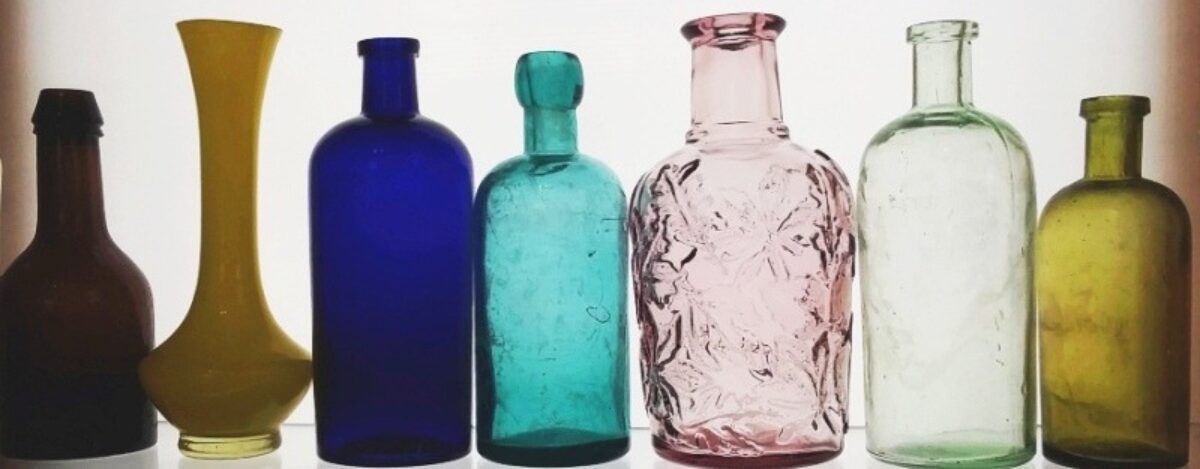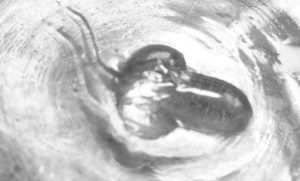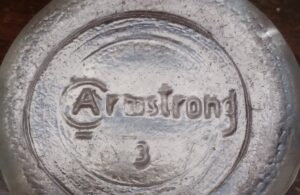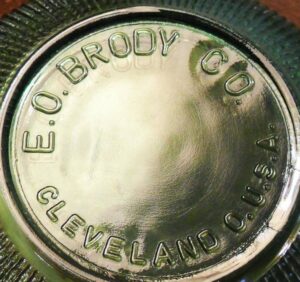Alphabetical List of Glass Manufacturers’ Marks (initials, logos, trademarks, emblems, signatures, hallmarks, markings) seen on Antique, Vintage and Modern Bottles, Fruit Jars, Insulators, Tableware and other Glassware, Page One. (A through B listings follow the introductory/explanatory notes, below)
[ A – B ] [ C – D ] [ E – L ] [ M – R ] [ S – Z ]
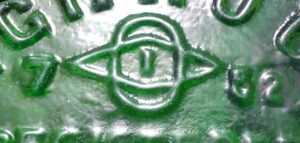
Welcome! I’m interested in the history of the glass industry in the United States, especially the manufacturing of bottles, fruit jars, electrical insulators and tableware. On these five pages I’ve attempted to compile a list of glass manufacturers’ marks (glass factory marks) found on (primarily) American bottles and jars. These glass bottle makers’ marks are sometimes called “punt marks”, especially within the container manufacturing industry.
Also included are a number of trademarks, emblems, signatures and logos seen on other types of glassware including tableware and industrial glass items such as electrical insulators and railroad lantern lenses. Entries on some of the more commonly encountered brand and company names (for instance, Bromo-Seltzer) as seen embossed on antique bottles are also included, as I frequently get questions about them.
Note: the picture above left shows the first trademark used by Owens-Illinois Glass Company – from 1929 into the mid- and late 1950s. This is a typical example, as seen on the bottom of an emerald green “High Rock” ginger ale bottle bearing a date code of 1952. As indicated by the number “7” to the left of the logo, it was made at their main glass plant (O-I plant #7) located at Alton, Illinois. I receive more inquiries about this mark than any other shown on the site, so I’m picturing it here at the beginning of the “Glass Bottle Marks” alphabetical listings pages. It is listed as “Diamond and oval superimposed (entwined) with I in center” (on page two) although oftentimes, especially on smaller bottles, the center “I” is poorly delineated, illegible or virtually invisible. The logo has been described by some observers as reminiscent of the planet Saturn, or a representation of an eye.
Note: For a brief, basic discussion on the material “glass” (without a lot of scientific jargon), please check out my webpage here: What is glass??
Also, please note: When searching the pages (and archived comments) of this website on a computer screen, it may be helpful to press the CTRL (and, while holding it down) the F (Find) key on your keyboard. Then type in a word or letters you are looking for in the search box. This should help to scan the text more quickly for a specific glass factory name, business or company name, city or state name, or other words or initials contained within the text.
If you are using a mobile device, look for the “three stacked dots” or “three horizontal lines” (Menu) along the top or bottom of the screen, tap and look for “FIND IN PAGE” in the dropdown menu. Select that option and a keyboard should appear. Type in the word or phrase to see if it appears within the text on that webpage.
The majority of the marks listed here are found on older glass items, but over the last few years I’ve also tried to include more of the commonly seen trademarks used by present-day glass manufacturing concerns here in the United States. I’ve also included a number of marks seen on glassware made in other countries around the world, but primarily those marks seen on glass that has been imported into the United States.
There are many, many glass manufacturing companies around the world that have made untold billions of glass containers, drinking glasses and other types of glassware, and my list shows only a small percentage of marks that might be encountered worldwide.
Also, please realize that there are a number of marks I list here that could potentially stand for an unrelated company from another country. For instance, in the case of some marks such as “G inside a circle” or “S inside a circle” or just an “M” , very similar marks, in fact basically identical, were also used by totally unrelated companies located outside the United States. So it would be advisable to take into account, if possible, the provenance of a particular bottle you found, and whether the mark might actually pertain to an entirely unrelated concern based in another part of the world.
The reference book “Bottle Makers and their Marks” by Julian Toulouse (1971) which this list is based on (discussed farther down on this page) contains an appendix listing of glass marks used by glass companies around the world, most of which are not listed here. Although the marks listed in his book were in use around the time the book was printed, it can still be very useful for finding worldwide marks, as some have not changed for decades.
For a comprehensive list of present day (or very recently used) glass bottle manufacturers’ marks from around the world, you might also wish to check out the following link showing many of the more recent marks (properly called “punt marks” on their website) which are sometimes seen on bottles imported to the United States. Click here to access a page on the Bucher Emhart Glass site with a link to a recently updated .pdf file illustrating many glass container marks used around the world: Emhart Glass Punt Marks Database (.pdf file)
For a very informative, comprehensive site with lots of detailed discussion on various aspects of antique bottles, including their many types, colors, shapes, methods of manufacture, uses, and clues to dating them, I strongly encourage readers to check out Bill Lindsey’s Historic Glass Bottle Identification and Information Website (hosted by Sha.org). The site is also known as the “Historic Bottle Website” (or HBW). His site is a MONUMENTAL work and has a wealth of great information posted!! There are many pages on the site, and in particular, this page on the site (linked here) includes a lengthy list of detailed articles written by Bill Lockhart (with help from other members of the “Bottle Research Group”) shown near the bottom of the page, under the heading “ENCYCLOPEDIA OF MANUFACTURERS MARKS ON GLASS CONTAINERS” :
Glass Bottle Makers’ Marks – Sha.org -List of Articles
A website that I would also heartily recommend, devoted to dairy-related antiques, is “dairyantiques.com” which is no longer “live” on the internet. However, using the “Wayback Machine” internet archive, please try viewing the site at the following link. I would encourage any milk bottle collectors to try searching their list of marks here: Milk Bottle Marks .
Click here to check another collector’s site that lists a few Australian and English marks seen on older bottles: Some Australian and British marks on bottles.
Australian Bottle Marks. Here is a YouTube video from Australia – “The Ultimate Recycler” channel presents a discussion on some of the more commonly seen base marks seen on antique and vintage bottles found in the Australia and New Zealand area. I enjoyed this video and certainly recommend it! Video with discussion on some Australian bottle marks
Another webpage which I recommend, especially to collectors of tableware and art glass, illustrates many glassmakers’ marks frequently seen on carnival glassware and other upscale glass. Although some of these marks are listed on my site, some of them are not. So be sure to check out Glass Makers’ Marks on Carnival Glass- David Doty’s Site !
Another site with an extensive list of marks is here: Carnival Heaven website – Glass Marks .
Here is another site, this one specializing on information concerning shot glasses: Shotglass.org – Marks Seen on Shotglasses. Most, if not all, of the marks illustrated there are frequently seen on other types of glassware as well, which makes the page quite helpful to a broader spectrum of collecting fields.
ADVERTISEMENT
Art Glass Marks and Signatures
Another very wide field of interest to collectors and researchers on antique, vintage and modern-day glass is what might be called, in a very general sense, “Art Glass”. My site doesn’t go into much detail on that type of glass (with a few exceptions, such as some pressed and blown glass makers including Fenton), but for a site that illustrates lots of signatures and marks used by art glass firms around the world which might be found on more “upscale”, “high end” handmade glass produced by such operations, large and small, please check out this webpage:
Art Glass Marks and Signatures – 20th Century Glass
ANTIQUE BEER & ALE BOTTLES
Researcher/historian Tod Von Mechow has compiled a large quantity of in-depth information on antique beer bottles, including both pottery and glass bottles. I would encourage anyone interested in makers’ marks on beer bottles (and soda bottles) to check out his site….. he has a very extensive list with a lot of great material on obscure glass and pottery companies: Sodas and Beers – Archives – Tod von Mechow’s Website
Some Marks seen on Beer Glasses
I recently found another website that concentrates on information pertaining to beer glasses from around the world, and one of the pages on that site illustrates a number of glass manufacturer marks seen on the bottom of beer glasses. Most, if not all of these marks are also seen on other types of drinkware and tableware. Some of those shown include marks I’ve never seen posted on any other website. So it might be worth a moment to check out this page: Marks Seen on Beer Glasses – Gulliver Taverns Webpage
Usually embossed on the base, marks may also appear on the lower heel area on certain types of bottles, especially sodas. On earlier historical whiskey flasks, fruit jars, and soda bottles, and especially examples produced in the mid-nineteenth century period (1840s-1860s), the full factory name or initials may be embossed across the front (face) or back of the bottle.
This list primarily includes marks that represent the actual glass company that made the container. Many marks are encountered that indicate the company whose product was contained within the bottle, or are trademarks (“brand names”) that give no indication of who actually made the glass, and those (with a number of exceptions scattered here and there throughout the text) are not included in this list.
From the standpoint of most collectors of antique bottles, the name and location of the company the bottle was made for, and the name of the product that was originally contained in the bottle (one or both of which may be embossed on the bottle) is often considered to be of more interest or importance than the glass factory where the bottle was actually manufactured. However, this site is geared with more emphasis on the actual glassmakers themselves. Hopefully this database will be of some help to those who are attempting to assign an approximate date range to a particular bottle or other glass item, assuming it carries an identifiable glass manufacturer’s mark.
NOTE: If initial(s) embossed on the base match the firm name (for instance, of a bottler or brewer) on the front of the bottle, the base mark will more than likely not be that of the bottle manufacturer, and so may not be listed here. This is frequently the case with soda, mineral water, beer and milk bottles of the 1880-1930 period, in which the initial(s) of the “end user” (the soda bottler, brewery, drug manufacturer or distributor, or dairy for which the bottle was made) appear embossed, often in very large bold letters, on the base.
This was especially true of many soda bottles, in which a large single letter is embossed very boldly on the bottle bottom. In those cases, it is believed that the initial (or initials) was marked prominently on the base so that the bottles could be identified and sorted quickly when being returned for washing and refilling. The bottles were often turned upside down when placed into partitioned cases, where the lettering would be readily visible.
Please keep in mind that some marks (esp. initials of early glass companies) may vary slightly in appearance and punctuation from one bottle to another. For instance, they sometimes occur with or without periods after each letter. These variations in punctuation were common and probably reflected the whim of the mold engraver, thus having little or no importance (i.e. for assigning date ranges) especially on marks of pre-1900 bottles. For the most part, I have not attempted to list fine distinctions for marks that are found both with and without periods.
Another source of confusion was the common practice of engraving the “G” (especially in the 1880-1920 period) to appear very similar to a “C”, the only difference between the two being a small stroke or “tail” pointing in a downward or “southeasterly” direction on the lower right-hand side of the letter G. Thus, the mark “A.B.G.M.Co.” might be misconstrued to read “A.B.C.M.Co.” Also, the abbreviation “Co” (Company) sometimes may be found embossed with either an upper- or lower-case “O” on various bottles made by the same manufacturer.
DATE RANGES shown on this site: The years of business (and date ranges given for various marks listed) shown on these pages are the best I have (so far) and I’ll freely admit that many of them are not precise, and are occasionally subject to change as more research is done and better info uncovered. I am always trying to update entries and keep abreast of the latest research, but am always “behind the curve” to some extent as there is so much to learn.
ADVERTISEMENT
There are discrepancies between dates shown on this site as compared to information from other sources (both online and in reference books). Earlier writers on glass including Helen McKearin, Kenneth Wilson, Rhea Mansfield Knittle, Julian Toulouse, Adeline Pepper, Dick Roller and others wrote books with the very best information they had at hand, and that was long before the internet age!
More recent (and ongoing) research by Bill Lockhart, Tod Von Mechow, Jay Hawkins and others have been very helpful in correcting and “fine tuning” date ranges for glass companies (and some of the marks each used for shorter periods of time while a particular company was in operation). The word “circa” or “c.” has been used rather heavily in these pages. Please keep in mind that I’d like the information presented here to be as accurate as possible, but as human beings we are not perfect and there will be mistakes here and there in the text.
Generally speaking, I may not be able to answer questions concerning bottles with only mold or catalog numbers embossed on the base. THOUSANDS of bottles carry only a number on the base (or heel), and this information (in many cases) does not help ID the source or age. Nearly all glass factories used mold numbers on their containers at one time or another. However, the general style, shape, manufacturing technique used, and glass color of a container can give strong clues to approximate age.
Numbers often served as some type of mold identification, indicating a particular mold used by a glass factory. If a number of identical molds were produced for making a certain type of bottle, they would often be serially numbered (such as 1 to 12). Some numbers served as date codes, or as some other type of internal code used by the factory. In the great majority of cases, bottles with only numbers on the base are difficult, if not impossible, to attribute to a specific glass maker. Please see my webpage here with more info on Numbers seen on the bottoms of glass bottles and jars.
Much of the basic information here on the alphabetical “Marks” pages comes from research by Julian H. Toulouse published in his classic, indispensable and ground-breaking reference work Bottle Makers and their Marks (1971). That 624-page book is the best reference work ever published on glass manufacturers’ marks on bottles, but admittedly it does contain quite a few errors which have been discovered over the last 50+ years since its original publication.
Other sources of information I have used (including reference books, magazine articles, websites, and in a few cases, email or voice communications) would include: Helen McKearin, Rhea Mansfield Knittle, Stephen Van Rennselaer, Harry Hall White, Alice Creswick, Dick Roller, William S. Walbridge, Cecil Munsey, Roger Peters, Gene Blasi, Adeline Pepper, Arthur G. Peterson, Bob Stahr, Fred Padgett, Rex L. Wilson, John O’Dell, Bill Lockhart, Jeffrey L. Giarde, David Bethman, Arleta Rodrigues, Frances Terrill, Joe Maurath, Jack Tod, Ray Klingensmith, Elton Gish, Douglas Leybourne, Jr., Vivian Kath, Betty Zumwalt, Jay W. Hawkins, Peter R. Guetig, Conrad Selle, Tod Von Mechow, Don Dzuro, Johnnie W. Fletcher, Norman “Ted” Oppelt, Dick Cole, Harvey Teal, Dean Six, Tom Neff, Bruce Mobley, Ron Fowler, Albert Morin, John P. Adams, Philip K. Huggins, Jack K. Paquette, Bill Lindsey, Carol Serr, Bob Brown, Peter Schulz, Beau Schriever, Russ Hoenig, Mark Newton, Lee Brewer and Dave Beeler, as well as many others.
In addition, I want to extend a hearty THANK YOU to the many individuals who have sent me photos of glass marks over the years. Some of those photos appear within the text of the alphabetical marks listings, with credit given to the contributor. (Most photos without a credit in the caption were taken by me).
This site also utilizes, to some degree, my own research and observations over several years of collecting & studying antique bottles, insulators and other glassware. I hope this list will be of assistance to those interested in antique bottles and other glass containers made in the United States and the history behind the factories that manufactured them.
I am striving to add more articles on this site relating to glass and glass collecting, both of a general nature, and addressing certain collecting “niches”, as time and energy permits! I hope you will return often to this site!! THANK YOU!!
I will occasionally be adding more data to these pages as I uncover more accurate information. The info presented on this site is the most accurate I’ve been able to find at present, but any comments (pro or con), clarifications or corrections (preferably backed up with reliable source information) would be sincerely appreciated!!!
Because of the volume of emails I receive, I may or may not be able to respond to questions about marks not listed here. You are more than welcome to contact me, (see Contact Information), but please be aware that this site is NOT intended as an appraisal service, and I may not respond to queries along the general lines of “what is this jar worth?” and “is this bottle worth the hassle of listing on ebay?”.
Often, I simply don’t know the answers to a lot of questions that are sent to me. The wide world of glass and bottle collecting is a TREMENDOUS field and there are many, many unanswered questions still out there concerning bottle markings, glass manufacturers’ histories, etc.
I should mention that only a small percentage of comments received are actually published on this site, since if every one was answered and published, my site would soon be loaded down with thousands of comments that could cause the pages to load more slowly for those with slower or older computers.
Thank you very much! David
COPYRIGHT ISSUES
I occasionally surf ebay and other online sales sites, and I have found that (very frequently) sellers copy and paste segments of text from this site, ranging from a few sentences to several paragraphs, or even many paragraphs, WITHOUT any credit as to the source of the information they are copying. Although my text is copyrighted by default, I can’t do anything to stop ebay sellers from copying and pasting content from this site. So I merely ask sellers to PLEASE include the source of the text you are using: please cite it as “courtesy of GlassBottleMarks.com”. Also, please keep in mind this website is free but costs money to keep “up and running”, and my costs are defrayed by having ads inserted on the pages. THANK YOU!
Please click here to go to my site Welcome / Home Page.
ADVERTISEMENT
Alphabetical List of Glass Manufacturers’ Marks on Bottles, Fruit Jars, Insulators, Tableware and other Glassware, Page One
Note: some glass marks are “pictorial” in nature, are hard to describe and are difficult to place logically in an alphabetical context. For a handful of marks that I haven’t been able to identify (yet), and which were also hard to decide where to place in the list – please check the images (entries) placed at the very bottom of the alphabetical listings on Page Five (S-Z).
[ A – B ] [ C – D ] [ E – L ] [ M – R ] [ S – Z ]
- A…………………The letter “A” is sometimes merely a mold letter (identifying a particular mold used by a glass factory). If it is an abbreviation for a glass factory, it could stand for one of several companies. One possibility: Agnew & Company, Pittsburgh, Pennsylvania (c.1854-1894+). See “A & CO.” mark. Another possibility would be Adams & Company, Pittsburgh, Pennsylvania (1861-1891). Originally Adams, Macklin & Company (1851-1861), they did manufacture at least one type of fruit jar circa 1866, lettered “Adams & Co. / Manufacturers / Pittsburgh, Pa.” on the front. However, the great bulk of their glass production seems to have been pressed pattern glass and high-quality tableware and novelties, especially throughout the later years of their operation. In 1891, they joined the merger known as the United States Glass Company. Note: If the bottle is machine-made, the letter “A” would indicate a much more recent company, perhaps Arkansas Glass Container Corporation, Jonesboro, Arkansas (1948-to date). See “A.G.C. in state of Arkansas” and next entry, below.
- A (on the base of mouth-blown soda bottles made in Great Britain)…………. uncertain. Many handmade soda / mineral water bottles (with applied-lip blob or crown-type tops and a somewhat rounded base) are found with an “A” on the bottom, sometimes with accompanying dots and number codes. The glass is most commonly of a light greenish color, as seen in many bottles from Britain. In these cases the mark is currently unidentified with certainty. One very strong possibility would be Alloa Glass Work of Alloa, Clackmannanshire, Scotland. The bottles appear to date from the c. 1880s perhaps up into the 1910s. (Thank you to archeologist Sandi Ratch for bringing these “A” marks to my attention) !
- A (stylized triangle with “A” as central motif)………….Arkansas Glass Container Corporation (Arkansas Glass), Jonesboro, Arkansas (1948-to date). I am not positive this mark has actually been used on containers. It has been displayed on their website. If you have up-to-date information on this mark, please contact me!

American Can Company – Glass Division logo (Photo courtesy Krisse Hale) - A (stylized logo – barred triangular design overlain by an oval, as shown in photo at right)……………… American Can Company – Glass Products Division (1962-c.1967). Successor to American-Wheaton Glass Corporation. (See “A W inside an oval” entry on this page, below). Bought out later by Midland Glass (see Midland mark – stylized M, frequently seen on the bottom of stubby type beer bottles).
- A & CO…………Adams & Company, Pittsburgh, PA (1861-1891) and/or Agnew & Company, also of Pittsburgh (c.1854-1894+). 1) Adams & Company is considered as the most likely producer of several “Clasped Hands” figured flasks from the 1860s bearing this mark on the front, as attributed by Jay Hawkins, researcher on early Pittsburgh glassmakers. If so, they were produced in the early years of that company before they began to concentrate (primarily) on pattern glass tableware. 2) In reference to Agnew & Company, there was a series of glass companies in the Pittsburgh area in which the Agnew family was involved, beginning as early as 1842 with Chambers & Agnew. Later, approximately 1854, the firm became John Agnew & Company (1854-1870); then, John Agnew & Son (1871-1876) and later simply Agnew & Company (1876-1892+). The most recent incarnation seems to have been “The Agnew Company”, which was in operation in 1894 (a bottle catalog from this company exists, dated 1894) which may have continued on for some time afterwards. Jars that are marked “JOHN AGNEW & SON / PITTSBURG PA” presumably date from about 1871 to 1876, and those marked “AGNEW & CO / PITTSBURG PA” would date from c. 1876 into the early 1890s. Also, please see “A” and “Agnew & Co”. entries.
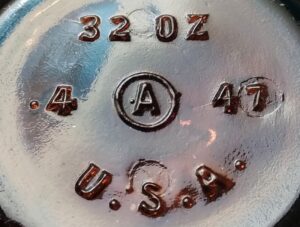
“A in a circle” on 32 ounce chemical bottle made by Armstrong Cork Company. The “47” is a date code for 1947. - A in a circle…………… Armstrong Cork Company (Glass Division), Lancaster, Pennsylvania; Millville, New Jersey [former Whitall Tatum Co. plant] and Dunkirk, Indiana [former Hart Glass Manufacturing Co. plant, acquired by Armstrong in 1938]. Mark was used from 1938-1969 on bottles, jars and electrical insulators. If there is a line underneath the “circled A”, this indicates the bottle was produced at the Dunkirk plant. The entire name “Armstrong” (with a circle around the “A”) is also seen on some bottles. Please eee “Armstrong”, as well as the next entry.
- A in a circle…………………. on earlier handblown or machine-made bottles (unrelated to Armstrong), probably American Glass Works, Richmond, Virginia ( 1907- 1925). This mark has been seen on the bottom of a few light aqua or colorless shoofly (“coffin”) flasks, picnic (“pumpkinseed”) flasks, and rectangular medicine bottles. Those bottles may date before around 1913. See “A G W” entry on this page. For more information on this particular “A in a circle” mark and American Glass Works, please see this article by Bill Lockhart and the Bottle Research Group: https://sha.org/bottle/pdffiles/AmGWRichmond.pdf
- A in a diamond…………Unknown
- A , entwined with a bird emblem with wings outstretched; appears as if flying through the “A”. The logo actually represents a crow (a play on the company name) with glass marbles clutched in its talons and beak, but may be mistaken for an eagle or other bird of prey…………………..Akro Agate Company, Akron, Ohio (1910-1914) and Clarksburg, West Virginia (1914-1951). Maker of toy glass marbles as well as ashtrays, vases, children’s dishes and many other unusual novelty items. Akro Agate items are found in a wide variety of opaque and “slag” (marbled, multicolored) glass.
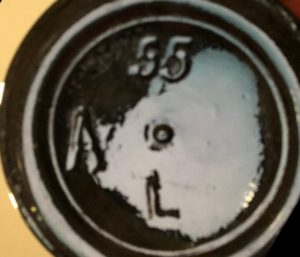
A / L / 55 – Unknown marking on dark olive green bottle (Photo courtesy David Hubbard) - A / L / 55 (Unknown manufacturer – see pic). This marking is on the base of a handblown “three-piece mold” dark olive green liquor bottle, with a label for W. Williams & Company, Aberdeen, Scotland, which was in business c.1897-1919. The bottle itself may be American, as the bottle was filled with whisky (in Chicago) that had been shipped over in casks from Scotland. Either the “A” or the “L” could be the first initial of the unknown glassmaker.
- A. Arbogast, Pitts…………..Alexander Arbogast / Arbogast & Company, Pittsburgh, Pennsylvania (c. 1860-c.1863). Mark is pictured in Bottles on the Western Frontier by Rex L. Wilson (1981:113), seen on a cylinder whiskey. See “Arbogast & Co. Pitts Pa”.
- A B (letters are not connected)………………uncertain, evidently either American Bottle Company or Adolphus Busch Glass Manufacturing Company. Please see AB (connected) page, “AB (connected) Co”, and “A.B.CO” entries.

AB (connected) mark on base of light aqua beer bottle – with P 11 code - AB (letters connected, shown) ………………….. Please see this page where this mark is discussed in more detail.
- AB (letters connected) Co…………….. Adolphus Busch Glass Manufacturing Company (1886-c. 1921) and American Bottle Company (1905-1929). Also, please see this page, and “A.B.CO.” mark.
- A B & Co (as seen on the base of blackglass ale or wine bottles)……….. Unknown maker. This mark has been seen on blackglass (very dark olive green or olive amber) bottles that appear to be from Great Britain, and probably date from sometime in the 1860-1900 time period. (There is no relation of this mark to the “A B CO” mark used by American Bottle Company). The letters are rather crudely and largely embossed, and arranged in a circular orientation on the bottom of the bottle. The bottles have been occasionally reported from such far-flung places as Suriname and Cuba, and were evidently exported around the world from Great Britain in the mid / late nineteenth century. If you have info on other places these bottles have been found, please contact me. These bottles are similar in general appearance to the black glass “C W & Co” bottles that were made by Carson, Warren & Company of Glasgow, Scotland.
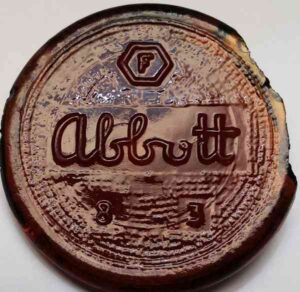
“Abbott” on base shard from amber bottle made by Fairmount Glass Company. - Abbott (in cursive script)………….. Abbott Laboratories, headquartered in Chicago, Illinois (1888- to present) . Although the surname “Abbott” is occasionally seen on bottles from several other, unrelated companies (such as on the C. W. Abbott bitters bottles from Baltimore), in this particular case the name, in a characteristic, rather stylish lettering, pertains to the pharmaceutical giant based in Chicago. The name was evidently embossed on a variety of bottles and jars that contained their pharmaceutical products. In the accompanying photo, the Abbott name is shown as it appears on an amber bottle base. The shard is from a bottle made by Fairmount Glass Company of Indianapolis, Indiana (F inside a hexagon). That bottle probably dates from the 1940s or 1950s.
- A.B.C……………..Atlantic Bottle Company, Brackenridge, Pennsylvania (c.1916-1930). First only a distributor (pre-1916), Atlantic was later an actual manufacturer of bottles. The Brackenridge plant was purchased by Owens-Illinois in 1930.
- A.B.Co……………………….. American Bottle Company (1905-1929). Chicago, Illinois (office – 1905-1916); Toledo, Ohio (office – 1916-1929). Glass plants were located at Streator, Illinois; Newark, Ohio; Belleville, Illinois; Massillon, Ohio & Wooster, Ohio. The American Bottle Company was purchased by Owens Bottle Machine Company in 1916 (with some of the plants being closed soon afterwards) but the Streator and Newark plants continued to operate under the American Bottle Co. name until 1929, when they became part of the merger that resulted in Owens-Illinois Glass Company. (For Streator and Newark plant marks from 1916 to 1929, see “17N” and “16S” entries). Most, if not all, of the “AB”, “AB CO.” and “A.B.CO.” marked bottles are believed to date between 1905 and 1916. However, it is possible that some bottles with these markings might date between 1916 and 1929, but, if so, could only have been made at either the Streator or Newark plants. See also “AB (letters connected)” page.
- A.B.G.CO………….. Adolphus Busch Glass Company (1886- c.1893) with a slight company name change to “Adolphus Busch Glass Manufacturing Company” (c.1893-c.1921). Also see the “A.B.G.M.CO.” mark which was used after about 1893 up to c. 1921, and this page on the AB Connected mark seen on Antique Beer Bottles.
- A. B. G. C. ST. L. ……………. Adolphus Busch Glass Mnfg. Company (Presumably produced at their St. Louis glass factory location post-1891). See next entry.
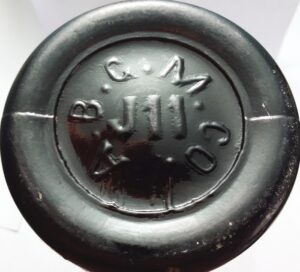
A.B.G.M.CO. mark on base of dark amber export beer bottle – Adolphus Busch Glass Manufacturing Company. - A.B.G.M.CO………… Adolphus Busch Glass Mnfg. Company, plants at Belleville, Illinois (1886-c.1905) and St. Louis, MO (c.1893 – c. 1921). The Belleville factory became part of American Bottle Company c.1905. (See AB (connected) and A.B.CO. marks). ABGMCO produced huge quantities of beer bottles for Anheuser-Busch Brewing Association, but also beer bottles for other brewers and bottlers, as well as other types of containers including soda bottles and wax sealer style fruit jars. Without the original label intact, it would be difficult or impossible to be sure what brand of beer any particular bottle marked “A.B.G.M.CO.” originally contained. The lettering is typically arranged in a circular fashion, and usually accompanied by a mold letter/number placed in the center of the base. Also see “A B G CO” which was evidently used in the first few years of operation.
- A.B.G.M.Co. Belleville Ill. ………………………… Adolphus Busch Glass Manufacturing Company, denotes beer bottles made at their Belleville plant (1886-c.1905). This marking is not very common, compared to other marks used by Adolphus Busch, so it is likely they used that mark for a relatively short time, with only a few shops (teams of glassworkers) producing them. The mold numbers “1” through “4” are known, but perhaps higher numbers exist that have not yet been reported.
- A.B.G.M.Co. ST. L………….. Adolphus Busch Glass Manufacturing Company, bottles made at their St. Louis plant location. See above entries, and AB Connected mark.
- A C B Co (letters arranged in a circular formation on base of early handblown light green or aqua Lea & Perrins Worcestershire Sauce bottles)…………… Aire & Calder Bottle Company, Castleford, Yorkshire, England (c.1836 – c.1913). The exact years this glassworks was in business is uncertain (sources of info vary), but a Lea & Perrins bottle (found among artifacts recovered from the October 1865 sinking of the sidewheel steamship SS Republic off the coast of Georgia) proves those initials were being embossed on bottles at least by that year, if not much earlier, possibly dating back to the 1840s or 1850s. These are believed to be the earliest Lea & Perrins sauce bottles that were exported to the United States.
- Acorn logo (shown, as seen on the base of a small medicine bottle)………Bellaire Bottle Company (Works), Bellaire, Ohio (1882-1922). Logo is occasionally seen on the base of handblown clear glass prescription/medicine bottles. This logo possibly dates from the earlier years of the company, perhaps up to circa 1895. (Thanks to David Bethman for emailing me with info on the source of this mysterious acorn mark!) He reports that the mark appears on a Bellaire Bottle Company letterhead shown in a reference book by Scott Tyson called “Glass Houses of the 1800s” (1971). For an article with more extensive background material on Bellaire Bottle Company, check out this .pdf file by researcher Bill Lockhart et al: https://sha.org/bottle/pdffiles/Bellaire.pdf
- Adlam’s Patent (on base of jars)…….. Several different jars are known with such embossings as “ADLAM’S PATENT” or “PAT. GLASS PAIL / BOSTON MASS” on base. They came with unusual metal screw lids; some lids are marked “ADLAM PATENT PAIL”. Patents were issued to Samuel Adlam, Jr. of Boston. These jars evidently date from the 1880s or 1890s. Currently, the glass manufacturer that made these jars is unknown / unidentified.
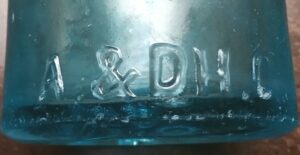
“A & D H C” mark on heel of blob top “squat” Schanzenbacher, Louisville KY mineral water bottle. - A. & D. H. C. ………………… Alexander & David H. Chambers, Pittsburgh, Pennsylvania (c. 1852–c.1889). This was one of the most prolific glass companies in Pittsburgh during the mid-to-late 1800s. Huge quantities of bottles, flasks, and fruit jars were made, as well as window glass (which was ostensibly their primary product). Many local, regional, and nationally distributed sodas, ales, mineral waters, beers, bitters, tonics, and other types of products were packaged in bottles made by A&DHC. Most commonly, bottles with this mark seem to date from the 1870s and 1880s, but the mark was evidently in use from around 1860. Most bottles made by A & D H C in the earlier years (1840s and 1850s) evidently did not bear a glass manufacturer’s mark. For more detailed background on A&DHC, please check out this article by Bill Lockhart et al here: https://sha.org/bottle/pdffiles/A&DHChambers.pdf
- Adams & Co…………. See “A” entry.
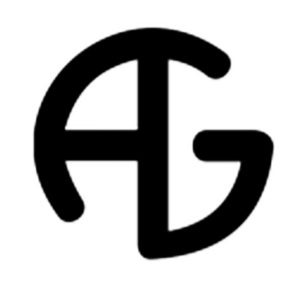
AG logo – A and G arranged in a circle, connected to form a monogram – ARCYA Glass Corporation. - AG (stylized letters joined together as a circle, as shown above)……………. Arcya Glass Corporation, Calamba, Laguna, Philippines and Makati City, Manila, Philippines (1966- c.2021?). Exact timeline for this mark is uncertain. The official Arcya website seems to have disappeared from the web by mid-2021. The factory was undergoing employee layoffs and chaos in November and December of 2020, evidently related to the Covid-19 pandemic. I believe this company was later acquired by another firm (possibly BestPak Packaging Solutions ?) sometime after 2021 but don’t have further information/clarification on that.
- AG (stylized letters forming an anchor)……..Anchor Glass Container Corporation. See “Anchor….” entry, farther down on this page.
- A G C (letters are diagonally arranged, oriented from “Northwest” to “Southeast”)………….Arkansas Glass Container Corporation, Jonesboro, Arkansas (1956-to date). See next entry.
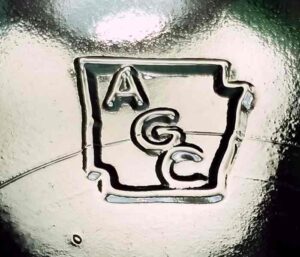
“AGC inside outline of the state of Arkansas” mark – as it appears on the base of a clear glass half-gallon packer jar. - AGC / A G C (letters placed within outline of the state of Arkansas, shown above) ……………….. Arkansas Glass Container Corporation, Jonesboro, Arkansas (1956 – to the present). This operation began as McSwain Glass Company in 1948, according to information posted on the company website history page. https://www.agcc.com/our-history . McSwain Glass Company had previously operated (as McSwain Glass or under other business names) at factories located at Fort Smith, AR and later at Memphis, TN (producing lamp chimneys and glass minnow traps at both locations) before moving to Jonesboro. In 1956 the company was purchased by J. T. White along with other investors and renamed “Arkansas Glass Container Corporation”. The first glass actually produced at Jonesboro under the new ownership was in the fall of 1957. The period of use of this particular mark is unclear, although it seems to have been used at least as far back as the very late 1980s and is still in use today [2024]. The mark is seen currently on grocery store shelves, for instance on packer jars containing certain brands of jellies, preserves and other food products. AGCC apparently specializes in “packer ware” for a large variety of food products sold at retail as well as canning jars for consumers’ home use. An earlier mark used by Arkansas Glass was “g A c” (larger capital “A” with smaller upper case “G” and “C” placed to left and right). See that mark under the “gAc” entry on Page Three. For more background on Arkansas, the McSwain Glass Company and other predecessors of Arkansas Glass, see this recently posted article by Bill Lockhart et al: https://sha.org/bottle/pdffiles/ArkansasGlass.pdf
- A. G. CO………………. Evidently used by at least three different glass companies including: Atlanta Glass Company, Atlanta, Georgia (1887-c.1892), Annapolis Glass Company, Annapolis, Maryland (1885-c.1887) and Alexandria Glass Company, Alexandria, Virginia (1905-1916). The mark appears on the base of certain liquor flasks, soda bottles and other types of containers. Also, on the face of certain fruit jars, the initials “A.G.CO.” might stand for the American Grocery Company. For much more in-depth analysis of this mark and several related marks, (detailing different types of bottles that carry this mark, and info on which companies are more likely candidates for attribution to a specific type of container), please check out “The A.G.Co Logo” (Bill Lockhart et al), a pdf file, here: https://www.sha.org/bottle/pdffiles/AGCo.pdf
- A.G.M. (on glass containers most commonly found in Australia and New Zealand)…………….Australian Glass Manufacturers Company, Australia. Exact time period when this mark was used is unclear. A few examples are shown on this page: https://www.thebottledepot.com/web15.htm
- A G M (letters “G” and “M”, separated by horizontal line, inside a rectangularly drawn “A” with flat top) ……….. Australian Glass Manufacturers Co., Kilkenny, South Australia. Please see entry under “G M” on page three, with line drawing showing this mark.
- Agnew & CO…………See “A & CO.”
- Agnew & Son………..See “A & CO.”
- A. G. S. & CO……………………. A. G. Smalley & Company, Boston, Massachusetts (1877-1915). (Albert G.) Smalley & Co. was a distributor of fruit jars and other types of glass bottles for many years, and apparently did not manufacture the glass themselves but sold the product of unidentified glass makers – presumably located in the eastern US. The mark is seen on several jar variants, as well as on a few other bottles including a “Palmer & Madigan, Providence, R I.” liquor flask variant. For more details on Smalley and the glass they sold, see this article by Bill Lockhart et al: https://sha.org/bottle/pdffiles/AGSmalley.pdf
- A. G. Smalley & Co…………same as above.
- A.G.W…………………in some cases, American Glass Works, Pittsburgh, Pennsylvania (c. 1866-c.1905). American Glass Works reportedly manufactured mostly window glass prior to 1880, but also produced bottles and jars for many years. A number of different firm names (partnerships, business names) were involved in the operation of the works over the years. The exact time periods during which the AGW mark was used on bottles by the Pittsburgh operation is somewhat unclear, and the subject can be very confusing for researchers and bottle collectors. (See next 2 entries also). For several years the name of the glass company was changed to “American Glass Works, Limited”, and then changed back again, removing the “Limited”. For more detailed information on this mark and the “A G. W. L.” mark, see Bill Lockhart’s article here: https://sha.org/bottle/pdffiles/AmGWPittsburgh.pdf Also, check Jay W. Hawkin’s entry on this company in his reference book Glasshouses & Glass Manufacturers of the Pittsburgh Region – 1795-1910, pages 24-31. NOTE: It is also possible that some flasks with an “A G W” on the base might have been made by Arsenal Glass Works, Pittsburgh, PA (see entry for that company, farther down on this page). Also, please see next two entries.
- A.G.W………………..American Glass Works, Richmond, Virginia (1907-1925) and Paden City, West Virginia (1918-c.1935). Bottles (especially crown lip style soda bottles) of the teens and 1920s from the VA and surrounding area with “A.G.W.” marked on the base are virtually certain to be products of this company (not to be confused with the earlier American Glass Works of Pittsburgh, an unrelated company). Machine-made bottles date after 1916 (Toulouse 1971:23). The Richmond plant burned in 1925 and was not rebuilt. This company also used an “A in a circle” mark on some bottles such as coffin flasks and pumpkinseed flasks. In any case, that mark was primarily used by the Armstrong Cork Company from 1938 to 1969.
- A. G. W. (on bottles made in Great Britain)…………………. Attributed to Alloa Glass Work, Alloa, Scotland. Julian Toulouse writes “Probably circa 1900 to date”.
- A.G.W.L…………… American Glass Works, Limited, Pittsburgh, Pennsylvania (c. 1887-c. 1893). Advertisements exist which show this company produced a large line of Hutchinson type soda bottles, as well as many other bottles including beers and mineral waters. The mark “A.G.W.L.” which appears on the heel of many Hutchinson soda bottles can be definitely attributed to this company. The glass works were moved from the south side of Pittsburgh to Redman Mills, PA around 1892. Although this particular mark (with the “L”) was evidently used only for a few years, the American Glass Works continued to operate (after having dropped the “Limited” in their name) until about 1905. I believe it is possible that both marks, “A.G.W.” and “A. G. W. L” could have been in use simultaneously, on some bottle molds, at least for some period of time during the late 1880s into the early 1890s. Please see the above two entries on “A.G.W.”
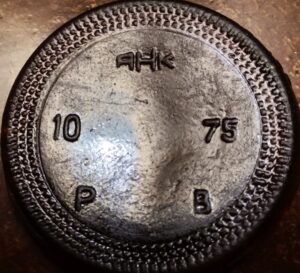
AHK (Alexander H. Kerr) mark on the base of an amber beer bottle shard dated 1975 - AHK (A H K)……………………Alexander H. Kerr & Company (see Kerr Glass Manufacturing Corporation), glass making plants at Altoona, Kansas (1909-1912); Sand Springs, Oklahoma (1912-1992); later plants at Huntington, West Virginia (1933-1983); Santa Ana, California (1943-1992); Plainfield, Illinois (1964-1996) and several other locations. Business offices were located in Los Angeles after 1919. The exact name of the Kerr company changed several times over the years. The first use of the AHK trademark by Kerr, according to U.S. Patent & Trademark Office records, was stated to have been on September 9, 1944. This mark was most commonly used on packer ware (jars, jugs and bottles for pre-packaged products sold at retail – such as mayonnaise, pickles, applesauce, coffee, etc.) as opposed to fruit jars for home canning. Most of the packer ware containers do not carry date codes so they can be harder to date than beverage bottles, such as soda and beer bottles which normally do bear date codes. The earliest beverage bottles I’ve seen with the AHK mark have “72” date codes. Julian Toulouse (Bottle Makers and their Marks, page 44) mentions the 1944 date, but also stated (in the same book) on page 544 that the AHK mark was used “since 1968” which seems contradictory. I believe he may have given that date in reference to when the first beverage bottles were marked with the AHK trademark? Or when Kerr acquired the former Whitall Tatum/Armstrong plant in Millville, New Jersey? For more detailed background info on Kerr and various marks used, see this article by Bill Lockhart et al: https://sha.org/bottle/pdffiles/KerrGlass.pdf
- Airko (on base of salt/pepper shakers)……………………… Airko Manufacturing Company, Clermont, Florida. This mark (often hard to read, and at a glance may be mistaken for Anko, Arko, Aiko or Aiiko) is seen on at least two styles of clear glass shakers. The most common type features horizontal raised rings or ribs encircling the shaker, similar in appearance to the Depression-era “Manhattan” pattern made by Anchor Hocking. Those shakers apparently date from the 1930s-1950s and their actual manufacture is attributed to Hazel Atlas Glass Company and/or Anchor Hocking (if you know which is correct, please let me know!). They were advertised as featuring a special design that helped keep the salt dry and free-flowing in humid weather. For an example of an advertisement, please see this page: https://chataboutdg.com/gallery/details.php?image_id=21647
- Aire & Calder Bottle Company…………… Aire & Calder Bottle Company, Castleford, Yorkshire, England (c.1836 – c.1913). This embossed marking is spelled out in a circular formation on the base of a dark olive-amber chemical/packer/utilitarian type bottle, probably dating from sometime in the 1855-1880 period. Also please see “A C B Co” entry.
- A. & J. ………………………….. A & J Manufacturing Company, Binghamton, New York. A&J specialized in manufacturing kitchen-related products such as mixers and egg beaters, and evidently the company had a business arrangement with Hazel Atlas Glass Co. to mark certain accompanying glass products. The most commonly seen item marked with those initials is a pitcher or large measuring cup that also served as the bottom container for a food mixer. That pitcher was patented in 1923. A & J was acquired by EKCO, of Chicago, IL, in 1929. Since those pitchers (in a medium green glass typical of Hazel Atlas during the Depression era) are fairly common and must have been made in large numbers, it is probable that many were made after 1929, continuing to carry the “A & J” marking after EKCO acquired the company.
- Albany Glass Works………… Albany Glass Works, Albany, New York (1847-1851). There WAS an earlier glass factory also called “Albany Glass Works” that existed near Albany (at Guilderland, NY) and that firm lasted from 1785 to 1815. But the bottles marked “Albany Glass Works” are from a later, unrelated company that bore a similar name. An iron-pontiled blob-top soda bottle in cobalt blue, and two types of historical flasks with the bust of Washington on them are lettered with this company name across the front, and those bottles evidently date between 1847 and 1851. HOWEVER, the great majority of flasks with this inscription found today are modern reproductions dating after the 1930s, with most having been produced up into the 1960s or 1970s or even later. If you have a flask with the marking “Albany Glass Works”, it is best to assume it is a repro until proven otherwise!
- A L R Co………………. unknown. These initials may stand for a distributing company. They are seen on the base of green glass floral containers which are similar to types marked “E.O. Brody Co.” and “Hoosier Glass”.
- Alton Glass Co………… Alton Glass Company, Alton, Illinois (c. 1871-1872). A handmade, applied lip coffin style whiskey flask is known which is marked across the front “MADE BY ALTON GLASS Co. / ALTON, ILL”. This company was evidently in business for about two years or less.
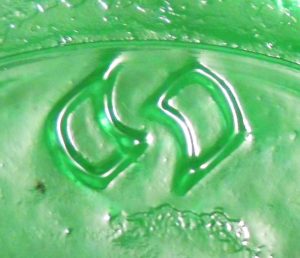
American National Can Company logo, on base of 1990 green soda bottle - American National Can Company (1987-2000) emblem. This particular logo was used from 1988 to 1995. The mark (shown in pic) is hard to classify, so I’ve pictured it on this page. This was photographed on the base of a typical emerald green non-returnable 16-ounce soda bottle with a 1992 date code. That type of bottle often contained a lemon-lime soda or ginger ale. Please also see a related mark, the “triangular logo” (which might be construed as a highly abstract “sailboat” representation) on page five.
- A.M.F.& CO……..Adelbert M. Foster & Company, Boston & Chicago (1893-1928). This was almost certainly a jobber / distributor, not an actual glass manufacturer. The mark appears on the bottom of druggist bottles. For more detailed info on A.M. Foster and related companies, see this article by Bill Lockhart et al: https://sha.org/bottle/pdffiles/AMFoster.pdf
- AMPAK ………………….. mark seen on base of clear whiskey flask, apparently of recent manufacture (c. 2000+). Ampak, based in Montreal, Quebec, Canada, maker/distributor of both glass and plastic containers.
- AM. TEL. & TEL. CO. (On glass telephone insulators)………………… American Telephone & Telegraph Company (formed in 1885), now known as “A T & T Corporation”, a subsidiary of parent company A T & T, Inc.. Most of the insulators marked with these initials are “toll” (long distance) style units. They were typically installed on long distance telephone lines that often ran alongside roads and highways connecting cities. That type is classed as “CD 121” in the Consolidated Design numbering and identification system used by insulator collectors. They were made by several glass manufacturers, including Hemingray Glass Company, Brookfield Glass Company, and others. These insulators date primarily from the 1895 to 1915 period.
- Anchor, or Anchor & chain (embossed design) on mouth-blown flasks……………….The pictorial representation of an anchor appears on many liquor flasks spanning (approximately) the 1830-1910 period, and many of these seem to be found in the general Baltimore, Maryland area. It is certain they were made by more than one glassmaker. Baltimore Glass Works certainly made some of them, and no doubt other glass companies in the Baltimore area also made them. The anchor may be placed either on the base, or on the front of the bottle. A variety of these would make an interesting collection in and of themselves.
- Anchorglass (one word)…………..trademark used by Anchor Hocking Glass Corporation. This mark dates from 1945 and was used into the 1950s or possibly later. Most items marked with this trademark have (or had) a foil label affixed, as opposed to permanent raised lettering (embossing) in the glass. Some Miller beer bottles in ruby red glass bear the word embossed on the bottom of the bottle. Please see my page on Anchor Hocking Glass Corporation.
- Anchor/H……………………….Anchor Hocking Glass Corporation.
- Anchor Hocking………………see Anchor Hocking Glass Corporation webpage (link above).
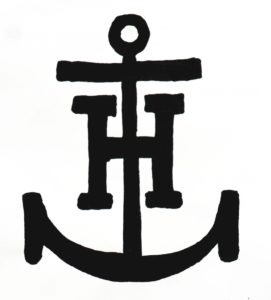
- Anchor and letter “H” entwined logo (shown)……..Anchor Hocking Glass Corporation, Lancaster, Ohio and other plant locations (1937-to date). For more information, see the link in entry below.
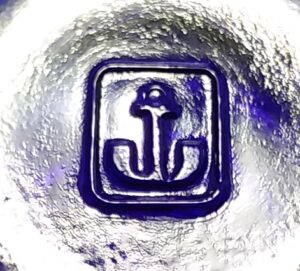
Anchor inside a rectangle or “Boxed anchor” mark used by Anchor Hocking ~ used from 1977 to c. 2000 or possibly later. Here on base of small cobalt blue dessert dish. - Anchor within a rectangle (shown above)…………..Anchor Hocking Glass Corporation, Lancaster, Ohio & other locations. (1937-to date). This mark used on their glassware since September of 1977. See Anchor Hocking Glass Corporation page.

Anchor Glass Container Corporation “Anchor” logo, this variation used from 1983 to 2014. - Anchor logo (pictured above – stylized angular “AG” letters, forming an anchor)……………..Anchor Glass Container Corporation, Tampa, Florida [head office], plants at Salem, NJ; Connellsville, PA; Winchester, IN; Shakopee, MN; Henryetta, OK; Jacksonville, FL; Elmira, NY; Warner-Robins, GA and Lawrenceburg, IN (1983-to date). (Anchor Glass Container Corporation was “spun off” from Anchor Hocking Corporation in 1983). AGCC has produced vast quantities of bottles and jars…………..liquor bottles, food containers, etc. This mark was used from 1983 to 2014. For some more info on this and related Anchor Hocking Glass marks, please check out this webpage on Anchor Hocking Glass Corporation.
- Anchor (inside vertical triangle with rounded corners, somewhat similar to a teardrop shape, shown below) – BSN Glasspack GmbH & Co. KG, Otto-Buchwitz-Straße 13, Bernsdorf, Germany (Deutschland). This mark is illustrated in a list of trademarks used by German glassmakers, published by Physikalisch-Technische Bundesanstalt (National Metrology Institute) in Germany, noted as active in 1971. Uncertain how long this mark was used, but I’ve seen it on the base of a green Jägermeister bottle that appears to date from the 1970s-1980s. The symbol is indistinct on some bottles and may look vaguely similar to a rock hammer, pickaxe, arrow, mattock or scythe.
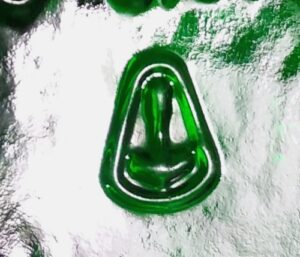
“Anchor or Pickaxe inside rounded triangle” mark used by BSN-Glasspack GmbH & Co, Bernsdorf, Germany. Photo shows the mark on the bottom of a green glass Jägermeister bottle. - Angel above Crown logo (shown below)………………………… Kerr Glass Manufacturing Company, Sand Springs, Oklahoma; Huntington, West Virginia; Santa Ana, California and other locations. This logo was used on the base of jelly glasses made by Kerr. I’m not sure about the exact time period it was used, but perhaps during the 1920s-1940s? Sometimes it is hard to be sure what the “angel” graphic is supposed to represent, although I would call it a “Winged Creature”. Dozens of different molds have been identified, each one with the image engraved a bit differently, since the engraving was done laboriously by hand on each mold. On some examples the figure has been characterized as a “bee” or some other type of winged insect.
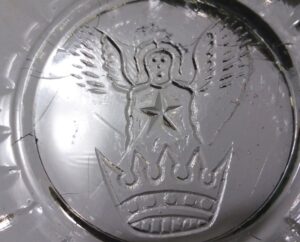
- Anko………….. see Airko.
- A O G CO …………………. uncertain meaning. These initials have been recorded on the bottom of at least three different bottles: a cylindrical generic chemical or druggist bottle; a rectangular colorless bottle lettered “Dr. Gunn’s Antiseptic – Made for Waco Electric Medicine Co / Waco, Texas” on the front; and a slug-plate type embossed druggist bottle from San Francisco. One possibility could be the “A. O. Goshorn Company” of Cincinnati, OH (a distributor of paint, glass, chemicals and other goods), but proof of any such connection remains elusive! The initials might stand for an obscure glass factory.
- A & P ………………. on the bases of Courtenay & Co. Worcestershire Sauce bottles, the initials stands for The Great Atlantic & Pacific Tea Company (the large chain of grocery stores). Although Courtenay & Company was based in Worcester, England, evidently their brand of sauce was marketed and sold for a long period of time by A&P in both Great Britain and the United States. The bottles thus marked are colorless (or nearly so) and were almost certainly made by an unidentified glassmaker in England. They generally appear to date from the 1880s to the 1920s period. Trade cards were published illustrating the product and the bottle, and many variations of those trade cards are known – bearing addresses of cities around the US, mainly Eastern and Midwestern locations, on the reverse of the cards.
- APG (as seen on base of small imported jar containing cocktail onions)………. APG Europe. Aluglas Packaging Group (based in Uithoorn, North Holland, Netherlands) merged with Verbeeck Packaging Group (based in Belgium) to form this company in 2017, specializing in a variety of glass and plastic containers, especially for the pharmaceutical industry, but for food and other products also.
- Arbogast & Co. Pitts. PA…………………Arbogast & Company (Alexander Arbogast), Pittsburgh, Pennsylvania (c. 1860-c.1863). See “A. Arbogast” entry. Obscure manufacturer that specialized in blackglass bottles. More detailed information on this operation (and many others) can be found in Glasshouses and Glass Manufacturers in the Pittsburgh Region 1795-1910 (2009) by Jay W. Hawkins.
- Arcoroc…………………………Brand name used by Arc International, France, for their commercial-grade glassware. See ARCOROC glass page.
- ARCYA Glass Corporation ………….. see the “AG mark” entry, above on this page.
- Ardagh Group (see U symbol, shown on page 5)
- Arko………………. see Airko.
- Armstrong (with a circle around the “A”, shown above)……………………………. Armstrong Cork Company, Glass Division. See “A in a circle”.
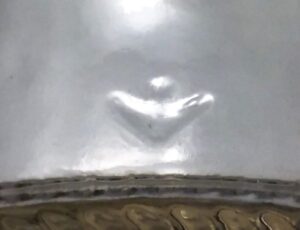
Anchor Glass Container Corporation stylized anchor or “downward pointing arrow” logo, introduced in 2014. Here on the lower heel of a clear Yoo-Hoo beverage bottle with 2022 date code. - Arrow (pointing downward)…………………….. Anchor Glass Container Corporation (1983-to date). Although this mark is another version of a “stylized anchor logo”, I would also characterize it as a “downward pointing arrow”. This is the most recent mark used by Anchor Glass Container on their glass bottles and jars, and typically appears on the lower heel area of the container. This mark was introduced in 2014. Anchor Glass Container Corporation is based in Tampa, FL (business headquarters) with 6 glass bottle manufacturing plants (as of 2019) located at: Shakopee, Minnesota; Lawrenceburg, Indiana; Elmira, New York; Henryetta, Oklahoma; Warner Robins, Georgia and Jacksonville, Florida. Two support locations (mold fabrication, equipment repair, etc) at Zanesville, Ohio and Streator, Illinois, were closed in 2018. For more info on this company and related companies, please see the “Anchor” marks, shown above, and my page on Anchor Hocking Glass Company.
- Arsenal Glassworks / Pitts PA ………. Arsenal Glass Works, Pittsburgh, PA (1865- c. 1869). The lettering embossed inside oval frame on lower front of figured flask, with eagle design on one side, and the image of a prospector, miner or traveler (with a “hobo stick” or bindle on his shoulder) on the reverse of the flask. The flasks are found in 3 different styles and are uncommon. (See also A. G. W.)
- Aseptic……………………….brand name seen on the base of clear druggist bottles. This line of druggist bottles was manufactured by Obear-Nester Glass Company, East St. Louis, Illinois (1894-1978). (See “N in a square” webpage). The ASEPTIC bottles might have been produced sometime in the 1917-1926 period. One example, marked “T. Ed Litt Drugs, Tucson, Ariz.” can be seen illustrated on page 105 of Michael R. Miller’s reference book “A Collector’s Guide to Arizona Bottles & Stoneware“(1999).
- A. T. & T. Co. (on telephone insulators)………….abbreviation for American Telephone & Telegraph Company. See AM TEL & TEL CO entry. The insulators with the marking “A. T. & T. Co.” were all made by Brookfield Glass Company, Brooklyn, NY.
- Atlas (on fruit jar)……….Atlas Glass Company, Washington, Pennsylvania (1896-1902), and the Hazel-Atlas Glass Company, Wheeling, West Virginia and other plant locations. (1902-1964). The ATLAS fruit jars were made in large numbers, with many minor variations, over a very long time.
- Atlas / H-A / Mason…………………..Hazel-Atlas Glass Company.
- Atterbury/Atterbury’s Patent June 30, 1863…………….(on fruit jars) Atterbury & Company (J.S. & T. B. Atterbury).

“AVON” embossed on base of black glass “Pot Belly Stove” men’s cologne bottle, circa 1970. - Avon…………………………Please see my webpage on Avon Bottles. A brief overview/discussion of Avon bottles including the glass figural bottles (such as the cars, etc) is presented there.
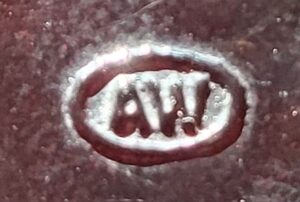
“AW inside an oval” logo, as seen on base of amber Orange Crush bottle with 1964 date code. (Photo courtesy of Jim Storm) - A W inside an oval………………………….. American-Wheaton Glass Corporation, Terre Haute, Indiana (c. 1959-1962). Became American Can Company, Glass Products Division in 1962, lasting until about 1967, then operated by Midland Glass Company in 1968. Midland was based in Cliffwood, New Jersey but also operated plants at Shakopee, MN as well as the Terre Haute facility. The “A W in an oval” mark was evidently used for some time after 1962, as an amber Orange Crush soda bottle bears a 1964 date code with that mark. Perhaps some of the bottle molds then in use were not retooled immediately after the renaming of the company in 1962? Please see “A” stylized logo on this page also.
- A. & W. ……………… probably Agnews & Wilcox, Pittsburgh, Pennsylvania ( 1868-1872). Jay W. Hawkins (Glasshouses and Glass Manufacturers of the Pittsburgh Region 1795-1910) gives this date range and writes on page 20-21 that this mark is attributed to Agnews & Wilcox, who made coffin flasks and soda bottles among other containers. Also, a flask marked “Guaranteed Full Pint” posted on the antique-bottles.net discussion site bears “A & W” on the bottom, but that bottle appears to date from sometime in the period of 1895-1915 and likely stands for a later, unrelated and unidentified company.
- B (as seen on glass electrical insulators, NOT bottles)………… Brookfield Glass Company, Brooklyn, NY and Old Bridge, NJ. A single capital letter “B” appears on numerous “beehive style” (CD 145) glass telegraph line insulators, positioned immediately below the wire groove that encircles the insulator. The letter is often very faint, and easily overlooked. There may or may not be a mold or “shop” number or letter on the very top of the insulator. On these insulators, the “B” positively identifies the insulator to be a product of the Brookfield Glass Company (Bushwick Glass Works), and most of these beehive style insulators date from the c. 1900-1920 period. Although some of the “B” beehive insulators were made at their first factory location in Brooklyn, the great majority of these insulators (which tend to be in somewhat darker shades of aqua, teal and green) are believed to have been manufactured at their second plant at Old Bridge, New Jersey. Please see my page on the Brookfield Glass Company for more background information.
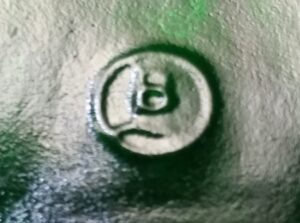
B with wavy underline, inside circle – Glashütten-Budenheim GmBH, Germany - B (with a wavy underline, inside circle)……………Glashütten Budenheim GmBH, Budenheim, Rhineland-Palatinate, Germany. This operation was formed in 1904 and glass bottle production was started in 1905 (making green champagne bottles in the very beginning). The company later became part of Gerresheimer Glass. This mark is illustrated with a line drawing in Toulouse (BM&TM, 1971-page 578), and stated to date from 1965. Uncertain how long the mark was used after 1965, perhaps into the 1980s? See photo of mark (above) as it appears on base of an emerald green Jagermeister bottle. That bottle is also marked “W. GERMANY” on base which would presumably date it before 1989.
- B (on certain handblown bottles, c.1910 or earlier)…………Uncertain. In some cases, perhaps Buck Glass Company. See next several entries. The letter “B”, in some cases, might be just a mold identifier letter, with no indication of the glassmaker.
- B (with 2 serifs)…………….sometimes Brockway Glass Company, Brockway, Pennsylvania (1907-1988). See “B in a circle“.
- B (with 2 serifs)………often the Chas. Boldt Company, (also at times known as Chas Boldt Glass Company or Chas Boldt Glass Manufacturing Company), Cincinnati, Ohio and Huntington, West Virginia, at least on many of their early liquor bottles and other ware made in the circa 1900-1919 period. NOTE : Manufacturer attributions of bottles with a “B” on the base are very confusing and (in my opinion) not completely certain. More information on the Chas. Boldt marks can be found here: https://www.sha.org/bottle/pdffiles/BoldtGlassCo_BLockhart.pdf.
- B (without serifs)………….in some cases, perhaps Buck Glass Company, Baltimore, Maryland (c.1909-1961). Buck Glass was sold to Knox Glass, Inc. in 1961.
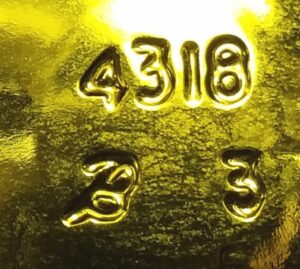
- B in cursive script (shown above)…………..Ball Glass Container Corporation, subsidiary of Ball Corporation. This mark used on some containers 1994-1995. See “BF”. See Ball Bros Glass Company.
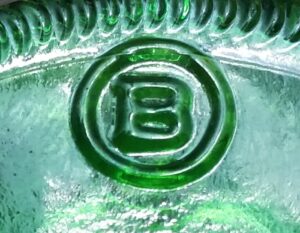
“B in a circle” trademark used by Brockway Glass Company, here on base of emerald green soda bottle. - B in a circle…………………..Brockway Machine Bottle Company (1907-1933) which became Brockway Glass Company (1933-1988), Brockway, Pennsylvania. This mark used from circa 1925 to 1988 or somewhat later (a bottle with a 1990 date code has been verified). The mark is very common and has been seen on innumerable bottles and jars of all types. For more information, please see my Brockway Glass Company / B in a circle webpage.
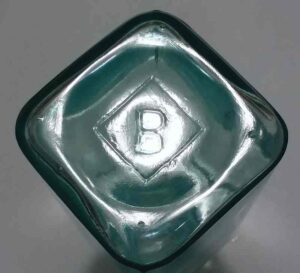
B inside a diamond ~ mark on the base of a blue-aqua horseradish or pickle bottle made by Binghamton Glass Company - B within a diamond (on the base of bottles, not tableware or novelty items, shown above) ………………………….. Binghamton Glass Company, Binghamton, New York (1880-1957). This mark has been verified on a few bottles. It likely dates from sometime in the 1880s-1910s period. For more information, please see this page: Binghamton Glass Company, Binghamton, NY. Also, see next entry.
- B within a diamond (as seen on colored ornamental and novelty glassware items such as small “hen on nest” dishes, toothpick holders, paperweights, salt cellars and figurines, but not utilitarian bottles)………………….. Boyd’s Crystal Art Glass, Cambridge, Ohio (1978-2014). Please see this page for more information: Boyd’s Crystal Art Glass
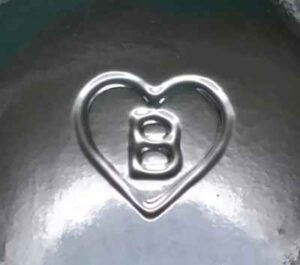
“B inside a heart” trademark used by Berlin Packaging, Chicago, Illinois. The mark is seen here on the base of a clear packer jar. - B inside a heart (seen on contemporary utilitarian packer jars)………………….Berlin Packaging L.L.C., corporation headquarters based in Chicago, Illinois (1988 to present). This company is a large supplier of glass, plastic and metal containers, with many distributing warehouses located worldwide. Berlin evidently wholesales the products of a number of glassmakers around the world, so the exact glass manufacturer (glass factory) that produced any particular container bearing this mark may not be easily identified. According to information on Justia.com, the “B in placed inside a heart” trademark has been in use by Berlin Packaging since June of 2016.
- B inside a triangle…….. Guernsey Glass Company, Cambridge, Ohio (1967-c.1988?)
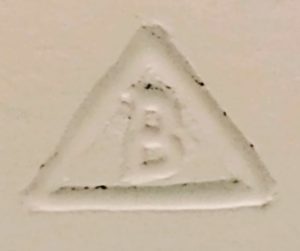
B in a triangle, as it appears on base of frosted light green rabbit dish made by Guernsey Glass Company (Photo courtesy of Deb Lane) Small hand-made operation, specializing in toothpick holders, open salts and other novelties in unusual colors. Only a small percentage of their product may have been marked with this logo. The “B in a triangle” stands for Harold Bennett, proprietor of the glass firm. Reportedly, the molds used were eventually sold to several other glass companies, including Mosser and Wilkerson.
- BA 2 (interspersed with various mold numbers and other codes, as seen on bases of ten-sided Bonne Maman brand preserve and jelly jars) …………. B A Vidro (B A Group or B A Glass) , based in Avintes, Portugal, the “2” indicating production at Marinha Grande, Portugal (1912-to date). B A (originally Barbosa e Almeida) has a long history of glass production with various mergers and acquisitions over the years, now owning/controlling glass factories in Portugal, Spain, Germany, Poland, Romania, Bulgaria, and Greece. According to the Bucher Emhart punt mark database, they use various plant numbers (from “1” to “12”) positioned to the right of the “B A” to identify various manufacturing locations, as shown in the database here: https://emhartglass.com/sites/default/files/publications/2020-10/BR0068%20-%20BEG%20Punt%20Marks%20Guide.pdf . According to their website, BA Glass now exports glass containers to about 80 countries worldwide. A history / outline of the company is here at this webpage: https://www.baglass.com/en/history.php
- Ball……………………Ball Brothers Glass Manufacturing Company/Ball Brothers Company (Ball Corporation after 1969), Muncie, Indiana and other locations (1888-1998) . Please see Ball Bros Glass Manufacturing Company page for a brief summary of this company.
- Ball Bro’s Glass Mf’G Co. Buffalo…………Ball Brothers Glass Manufacturing Company, Buffalo, NY (marking seen on glass fruit jar lids made c. 1885-1888). See Ball webpage for summary of this company.
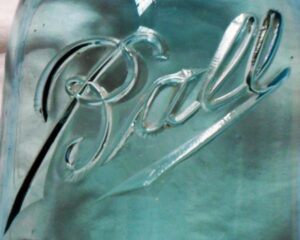
“BALL” logo, as seen on a BALL PERFECT MASON jar from the period c. 1910-1923. The exact cursive style changed slightly several times over the years. - Ball Perfect Mason…………….see this page with a brief summary of this popular jar, as well as Ball Bros Glass Manufacturing Company page.
- Baltimore Glass Works………………..Baltimore Glass Works, Baltimore, Maryland (c.1800-1905, which includes a succession of firms). Various flasks and bottles are marked with the full factory name, and the majority of these probably date between 1830 and 1870. Also, see B.B. & Co.
- B.& A.C.CO…………Baker & Adamson Chemical Company (1881-1913). Producer of acids and other chemicals. Although not the mark of a glass factory, this may be mistaken for one. Seen on the base of chemical and acid jars and bottles, most of which probably date from the early period — 1881 to 1900. B&A was bought by General Chemical in 1900, and in 1913 General became a division of Allied Chemical & Dye Corporation, later Allied Chemical Corp. ACC merged into Allied-Signal and that company is now part of Honeywell, Inc.
- BANNER …………………… trademark used by Obear-Nester Glass Company, East St. Louis, Illinois (1894-1978), for one of their lines of druggist bottles. Confirmed on the base of a clear rectangular pharmaceutical/prescription bottle. According to Arthur G. Peterson’s “400 Trademarks on Glass” this was used beginning in 1899. No information on ending date.
- “Belt Buckle” logo (oval shape with line through center) ……….Western Glass Manufacturing Company, Valverde (Denver), Colorado (c.1900-1909).
- B B (0n American-made bottles)………………..Berney-Bond Glass Company (1905-1930), see entry under “B B G CO”.
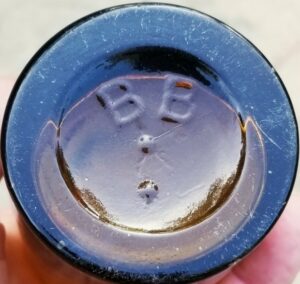
BB on base of unidentified applied-lip yellow olive amber mineral or soda water bottle, probably from Great Britain. There is no embossing on the sides of the bottle. (Photo courtesy of Jimmy Bray). - B B (as seen on base of “generic” yellow olive amber mineral water or soda bottle with applied lip, probably of British origin)……………………..unidentified with certainty, but this mark might stand for Bateson Brothers, Liverpool, England. The Bateson Brothers glassworks operated for many years from the late nineteenth century and well into the 20th century. (Thanks to Jimmy Bray for the photo, and Sandi Ratch for her help with research info).
- BB48…………….Berney-Bond Glass Company (1905-1930), see entry under “B B G CO”. NOTE: Milk bottles bearing the mark “BB48” were also made by Owens-Illinois Glass Company for many years after Berney-Bond was no longer in existence. In cases such as this, the Owens-Illinois mark (diamond superimposed with O and I) will also be seen on the base. Most of the bottles carrying both of these marks were made at the former Berney-Bond glass plant at Clarion, PA, which became O-I plant number 17. I am not sure how late the BB48 mark was retained on Owens-Illinois milk bottles made at this plant, but have seen a bottle with a 1947 date code.
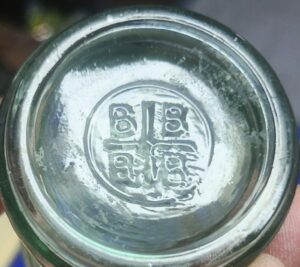
BBBB logo on base of light green-aqua ink bottle (Photo courtesy of Paul McClure) - BBBB / B B B B (Cross or “Plus” sign (+) with four letter “B”s – one letter placed in each quadrant)…………………….. Unknown / unidentified (shown here). This mark has been seen on the base of a few handmade ink bottles, possibly made in Great Britain sometime in the late 1800s or early 1900s. If you know what this mark stands for, please let us know!
- B B CO……………in most cases, probably Bell Bottle Company, Fairmount, Indiana (c. 1913-1915). Bell Bottle made milk bottles, so if the mark is on a milk bottle, Bell is the most likely source. Other possibilities include Berney-Bond Glass Company (1905-1930, see B.B. G. Co. entry below), and Bellaire Bottle Company, Bellaire, Ohio (c.1885-1921+). The “B B Co” or “BB Co” initials are also sometimes seen on the front of some beer bottles and other types of unrelated bottles and in those cases the initials don’t pertain to a glass manufacturer.
- B. B. & Co. ……………… Baker Bros. & Company (proprietors of the Baltimore Glass Works), Baltimore, Maryland (1852-1905). Mark seen on the base of Baltimore-area aqua blob beer bottles from the c. 1880-1895 period. (Thanks to Greg Franklin for supplying info on this mark!)
- B B G CO………….Berney-Bond Glass Company (1905-1930). A merger of the Bond Glass and Berney Glass companies, plants were located in Bradford, Hazel Hurst, Smethport, Clarion, and Knox, all in the state of Pennsylvania; the Winslow Glass Co. plant at Columbus, Ohio was purchased in 1927. Berney-Bond was bought by Owens-Illinois in 1930. Most of these plants were closed down in later years, until by the early 1970s only the Clarion plant (Owens-Illinois plant #17) was still making bottles.
- BBGMCO (monogram on jars)……..Ball Brothers Glass Manufacturing Company, Buffalo, New York (used on fruit jars c.1886-1888 before move to Muncie, IN.) See “Ball”.
- B-C …………Bartlett-Collins Glass Company, Sapulpa, Oklahoma (1914-1929); Bartlett-Collins Company (1929-2008). B-C mark (the letters enclosed in conjoined circles) was used on tumblers after 1921, but I do not know how long after that the mark was used. Manufacturer of a wide line of tableware over the years, Barlett-Collins was later a subsidiary of the Lancaster Colony Corporation (owner of Indiana Glass Company after 1957). Bartlett-Collins produced items such as jars, mugs, canisters and votive candle holders under the brand name “Indiana Glass”. The Bartlett-Collins plant was eventually purchased by Anchor Hocking Company, and shortly thereafter closed down (as of June 2008). Items made there during the Lancaster Colony Corporation years, in general, do not carry an embossed maker’s mark. A sister plant operated by Lancaster, located at Dunkirk, Indiana (the original “Indiana Glass Company” factory) ceased production of glass in 2002. See “Indiana Glass” and “LCC” marks. For much more detailed info on Bartlett-Collins and the history of the Premium Glass Company and other organizations involved in the earlier history of the plant, see this article written by Bill Lockhart et al: https://www.sha.org/bottle/pdffiles/BartlettCollins.pdf
- B & Co [o is underlined], below a triangle…………….. Uncertain, but possibly Bagley & Company, Knottingsley , England (see next entry). Triangle has number “500” embossed within, on the example reported, but perhaps a different number appears on other containers? Handblown, odd lip jar, off-clear glass w/perhaps faint grey-amethyst tint. (Reported by Sam Lawson).
- B & Co ; B & Co Ld ; B & Co Ltd……………………. Bagley & Company, Knottingsley, Yorkshire, England (1871-c. 1960s) . All three variations of the mark have been observed, and are believed to be from the 1890s-1920s period. They are seen on various pickle bottles and other condiment/food bottles. Bagley & Company Limited was incorporated as such in 1898 so the marks that include the “LD” or “LTD” presumably date after that year. For more background information on this glass company, please see Bill Lockhart’s article at this URL: https://sha.org/bottle/pdffiles/Bagley&Co.pdf
ADVERTISEMENT
- Bee (insect, an image of a bee with the letters “H” in left wing, “I” on body and “G” on right wing)…………………………………John B. Higbee Glass Company, Bridgeville, Pennsylvania (1907-1918). Seen on pressed glass tableware and novelties, most commonly in clear glass. NOTE: this mark, or a very similar mark, has also been embossed on reproductions made by other glass companies in later years, although in those cases the “Bee” is said to have no letters visible. I would strongly recommend more in-depth research on Higbee and the glass they made before attributing a particular item to that glass factory.
- BF……………….Ball-Foster Corporation (mark used 1995-2000). In 2000 became Saint-Gobain Containers, with the SG mark being instituted. See Ball Bros Glass Company.
- B.F.G.CO………………….Beaver Flint Glass Company, Toronto, Ontario, Canada (1896-1939). Maker of druggist, nursing, and other medicine bottles in clear and cobalt blue glass, mostly found in Canada. The Beaver Flint Glass Co. was evidently primarily a jobber, not an actual bottle manufacturer, and probably sold ware made by Diamond Flint Glass Company, Diamond Glass Company and later Dominion Glass Company in Canada. Also, see next entry.
- B.F.G.Co…………………. Beaver Falls Glass Company, Beaver Falls, Pennsylvania (1869-1879). This mark is seen on a few early telegraph insulators (all rather uncommon) as well as on certain blob top soda/mineral water bottles of the 1870s. Of course, this company had no connection whatever with the Canadian firm mentioned in above entry. Here’s an article listing the various types of insulators attributed to Beaver Falls Glass Co: https://www.insulators.info/articles/beaver.htm
- B.G.CO……………this mark was used by a number of different companies, and there is still uncertainty on absolute attribution in many cases. On earlier blob-top “export style” beer bottles and soda bottles, usually Belleville Glass Company, Belleville, Illinois (1882-1886). The Belleville factory was purchased by Adolphus Busch Glass Manufacturing Co. in 1886, and presumably the B G CO mark was discontinued soon after, being replaced by A.B.G.CO. or A.B.G.M.CO. The “B.G.Co.” mark was also used by Burlington Glass Works, Hamilton, Ontario, Canada (1875-1909) on the face of their “Burlington” fruit jars. A Moxie soda bottle variant with a crown lip carries the B.G.CO. mark, and in that case would have been made by an unidentified factory some time after 1892 (the year the “crown” style lip was introduced). “B.G.CO.” is also reported on the heel of a light green crown lip Anheuser-Busch Brewing Association beer bottle that appears to date from the 1910s or 1920s. The maker is uncertain. On some milk bottles, B. G. CO. was apparently used by Buck Glass Company, Baltimore, Maryland. (Buck normally used just a “B”). Binghamton Glass Company, Binghamton, NY (which used a “B in a diamond” mark on a few bottles) is another possibility in some cases, although there is no proof of this. If you have information that could shed more light on the BGCO marks, please contact me.
- B G W (on the side of a “fat” dip mold ale or stout bottle, possibly c. 1800-1830, found in the Baltimore, MD area) ……………………….. Uncertain meaning, but it is possible the initials, in this particular case, stood for the Baltimore Glass Works. See this webpage: https://bottleden.com/frederick2.shtml (Also, see “Baltimore Glass Works” above, also next entry).
- B G W……………… this mark was almost certainly used by Bushwick Glass Works, Brooklyn, New York (1864-c.1912) on a few soda and beer bottles: An aqua blob-top soda bottle marked “Minck Bros. & Co / Brooklyn” is known with B G W on the base along with a mold number (thanks to researcher Lee Brewer) . The mark has also been reported on a few other handblown beer bottles from towns in the state of New York, including bottles marked “James A. Holmes, Auburn, N Y” and “D. LaGrange, Moravia, N. Y.”. The mark may or may not include periods after each letter. Bushwick Glass Works is better known as Brookfield Glass Company. A similar mark might also have been used in a few cases by Binghamton Glass Works/Company, Binghamton, New York (1880-1957), but there is currently no concrete proof, as far as I know, for that company’s use of the mark. For more background info, check out this article by Bill Lockhart et al: https://sha.org/bottle/pdffiles/BinghamtonGCo.pdf ALSO: There is no solid evidence that Burlington Glass Works/Company (of Hamilton, Ontario, Canada) ever used the letters “B G W” on any glass they produced. (That belief was probably started by Julian Toulouse in “Bottle Makers and their Marks”, stating it was used from 1875-1877). If you have evidence that would indicate otherwise, please let me know.
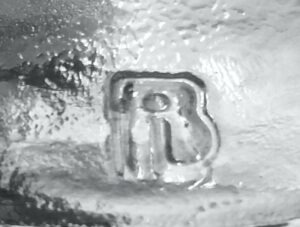
Ball-InCon Glass Packaging Corporation (mark used 1987-1994) - BI (or “I B”, a stylized logo/monogram consisting of “B” with lower-case dotted letter “I” incorporated within the letter “B”)……………………Ball-InCon Glass Packaging Corporation (mark used 1987-1994). Ball-Incon was formed as a merger of the glass plants owned by Ball Corporation, combined with the Indianhead Container Corp which consisted of glass plants at Laurens, SC (the Laurens Glass Works plant); Port Allegany, PA; Madera, CA and other locations. See Ball Bros Glass Company.
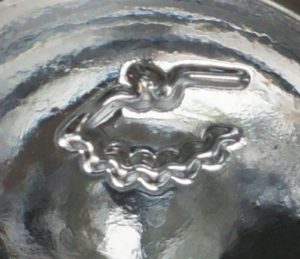
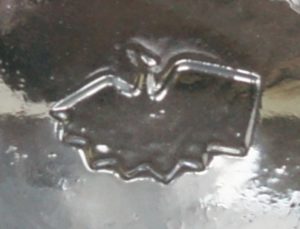

- Bird in flight logo or emblem (shown)………………….. three logos were used by Phoenix Packaging, based in Montreal, Quebec, Canada (1980- to date). A reader of this page, Dawn High, who was trying to find the user of one of these “bird logos” as it appeared on the base of an olive oil bottle/cruet, introduced me to this (formerly unidentified) mark. Now, thanks to Joel B. Miller, more info can now be published revealing the user of these marks! Two “older” logos (both with a more “horizontal” look) were used from approximately 1980 to 2014. Their third bird logo (with a somewhat more “vertically oriented” design) is currently in use, introduced on new molds in 2014. Phoenix Packaging contracts with many customers around the world to have special glass container designs produced to their specifications. Many different glass bottles and jars have been made, as well as packaging in other mediums such as ceramic, plastic, wood, metal, etc. Several dozen glass manufacturers have been involved at some time over the last few decades, including well-known glass container firms such as O-I and Verallia. (Thanks very much to Joel B. Miller for info and photos of those logos shown here).
- BiXby………………… S. M. Bixby & Company, New York, New York. (1862-19?). For a brief summary of this company, see this page: S. M. Bixby Company Bottles.
- Blenko Handcraft (usually seen on paper or foil labels) ………………………….. Blenko Glass Company (began 1893, later, at Milton, West Virginia since 1921). Maker of beautiful hand-made blown glass in a wide range of bright colors; the most popular item ever produced would be their widely-recognized “Water Bottle” with a very characteristic shape. This bottle has been made in many, many colors since 1938. A wide variety of handmade items are produced, some of them from hand-carved wooden molds as well as iron molds. Very few Blenko glass articles were marked (in the glass itself), but here is a page with more info on various Blenko glass marks and labels: http://www.blenkocollectors.com/blenkocollmarks.htm The official Blenko Glass Company website is here: http://www.blenko.com
- B. L. Fahnstock Fortune & Co. Pitts. Pa. ……………..Fahnstock, Fortune & Company, Pittsburgh, Pennsylvania (1866-1873). Mark seen on the base of wax sealer and “Kline stopper” type fruit jars. This company was evidently sold to Evans, Sell & Company in 1873. See “F. A. & Co” and “E. S. & CO.” marks.
- BLUE RIBBON…………………. Standard Glass Company, Marion, Indiana (1906-1933). Trademark is found embossed on the bottom of their line of clear (“flint”) rectangular druggist/drugstore/pharmacy/prescription bottles. The bottles are found in a range of sizes, and either “plain” (unlettered), or with a “plate mold” embossing – bearing personalized raised lettering for a local druggist, often with street address, city and state. This “Blue Ribbon” trademark was first used in 1908, according to information published in Arthur G. Peterson’s 400 Trademarks on Glass (1968). Standard Glass Company was bought by Foster-Forbes Glass Company in 1933.
- B. M. & Co. ………………….. Benton, Myers & Company, Cleveland, Ohio (c. 1876-c. 1904). This mark appears boldly embossed on the bottom of a mouthblown, applied lip “ginger oval” or bluing type bottle in light aqua glass. That bottle is a standard “generic” type with embossing only on the base, and the example bears a paper label for “Dr. Frazier’s Root Bitters” which was an obscure brand of bitters from Cleveland. The bottle itself was made by an unidentified glassworks, likely of 1870s or 1880s vintage. The mark has also been seen on the front of two variations of clear “turtle” style baby nursing bottles from the 1880s – one type has the B M & Co lettering placed inside an eight-pointed star, and another one with the lettering inside a diamond. Benton, Myers & Company, apparently a longtime wholesale jobber of drugs, liquor and other items, was previously named “Benton, Myers & Canfield” – at least as early as 1864, possibly earlier.
- B.& M.S.Co……….Bottler’s & Manufacturer’s Supply Company, Long Island City, NY (c.1897-1920). Seen on heel of New York City-area blob beer bottles.
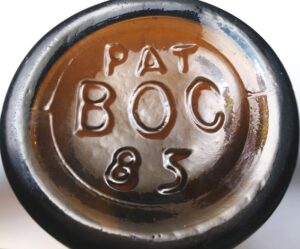
Unidentified B O C mark on base of amber handmade beer bottle - B O C……………..Unknown (Seen on base of amber quart “blob lip” beer bottle, c. 1885, shown here in pic). Although it has been proposed by some researchers that this mark is merely a mold-cutting error for “D.O.C.” (see that entry), I am doubtful and believe that this actually does stand for an obscure, short-lived glass company (or bottling or brewing firm) with those corresponding initials. The embossed lettering is very strong and bold on this bottle. If anyone comes across a bottle with the “B O C” mark on the base, I would love to hear from you. If the location of finds can be noted, this might give us clues pointing to the area (city, state) where these bottles were most likely made.
- BODE……………..Bode Extract Company, Chicago, Illinois (Gustav Augustus Bode, proprietor). Mark seen on the heel of a few hutch soda bottles. Bode evidently manufactured bottles from c. 1890 to 1892, but thereafter concentrated on the production of extracts. He passed away in 1900. Thanks to Joel Ferguson for sending me this info!
- Boldt………………. Chas Boldt Glass Company, Cincinnati, OH and Huntington, WV (1900-1926). For much more detailed info on the various marks used by this company, see this webpage: https://sha.org/bottle/pdffiles/CharlesBoldt.pdf
- Bottle (upside-down bottle superimposed over a capital G)………………….. Graham Glass Company, Evansville, Indiana . This mark was introduced in about 1913. See “Graham”.
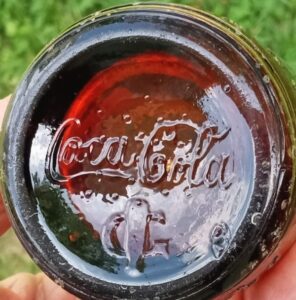
Upside down bottle superimposed over capital G, as seen on amber Coca Cola bottle (photo courtesy of Clifford Campbell). - Bottle inside an oval (embossed design/emblem showing a bottle inside an oval, seen on the base of green “Ten Pin” or bowling pin style soda or mineral water bottles which appear to be of British origin)…………….unknown meaning, but presumably the mark of an unidentified glass bottle manufacturer from Great Britain. Please see this webpage: Bottle within an oval mark.
- Boyd’s Crystal Art Glass, Cambridge, Ohio . (B in a diamond mark on upscale glassware indicates that company.)
- Boyd’s Genuine Porcelain Lined Cap (or ‘Genuine Boyd Cap for Mason Jars’, other variations)………. marking seen on white milkglass inserts (discs or lids) used with zinc lids on “Mason” type fruit jars. Please see this page for more information.
- B. P. & B…………………Bakewell, Page & Bakewell, Pittsburgh, Pennsylvania (1824-1836)
- B.P.CO……………Brunswick Pharmacal Company, New Brunswick, New Jersey. Seen on small cobalt medicinal bottles, dating perhaps from about 1895-1930. Bottles are also marked with a “back-to-back PP” inside a circle. Actual glass manufacturer is unknown, but Maryland Glass Corporation, Baltimore, MD (a prolific maker of cobalt blue bottles after 1907) could be one possibility. The “B.P.CO.” marking bears no relationship to the next entry.
- B.P.& Co………Beck, Phillips & Company, Pittsburgh, Pennsylvania (c.1866-1886+). Seen on the base of wax sealer fruit jars. Some similar jars are also found lettered “Beck, Phillips & Co. Pitts. Pa” in a circle on the base. McKearin (1941:611) indicates this company changed its name to “Phillips & Company” in 1874, and was still operating in 1886. The actual ending date was not given. So presumably the jars found with either of these marks would date between about 1866 and 1874.
- Bridgeton Glass Works …………… Bridgeton Glass Works, Bridgeton, New Jersey (c. 1855-c.1870) . The full factory name is spelled out across the face of several known soda bottles. This glass factory operated under the ownership of at least three or four different business firms during it’s long history, including J. Bodine & Sons. The bottles with the actual “Bridgeton Glass Works” embossing are generally believed to date from the 1855-1870 period, but it’s possible some bottles with that marking might date somewhat earlier.
- Brockway……………..Brockway Glass Company, Brockway, Pennsylvania (1907-1988). See “B in a circle” page. Most bottles I have seen with the cursive “Brockway” marking, usually embossed on the base, appear to date from the 1950s-1970s period, although I don’t know the exact period of use of this mark.
- Brody (E. O. Brody Co)………………… E.O. Brody Company, Cleveland, Ohio (1958-to date). This is not a glass company, but a distributor of products made especially for the florist industry. For more information please check out this page: E. O. Brody Company.
- Bromo-Seltzer / Emerson Drug Co. / Baltimore, MD. (usually embossed across the face of the bottle)………………………. Bromo-Seltzer was an extremely popular drug, in the form of a powder, introduced circa 1891. For more information, please see the Bromo Seltzer page.
- Brookfield (On glass electrical insulators, shown at right)…………………. Brookfield Glass Company (1864-1921) with factories at Brooklyn, New York and Old Bridge, New Jersey. For more information, see Bushwick Glass Works (Brookfield Glass Company) page.
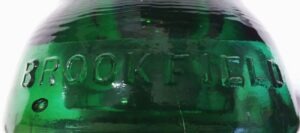
“BROOKFIELD” embossed on skirt of emerald green CD 152 style telegraph line insulator made by Brookfield Glass Company at Old Bridge, New Jersey - Brookfield (On milk bottles)………………… See this page on the Brookfield “Baby Face” milk bottles.
- Brooklyn Glass Bottle Works………………..Brooklyn Glass Bottle Works, Brooklyn, New York. Time period when this plant was in operation is uncertain. From the type and general style of bottle which carries the mark (early cylinder whiskey), it looks like the company was probably in operation during the 1860s or 1870s.
- Brooklyn Glass & Mfg. Co …………………….. Brooklyn Glass & Manufacturing Company, Brooklyn, NY (c. 1897-c. 1899). An amber strap-side liquor flask is known with the marking “BROOKLYN GLASS & MFG CO / 338 B’WAY / BROOKLYN NY” embossed on the base. This seems to be a very scarce mark and I have not seen another bottle with this lettering on it. This firm appears to have been in operation much later than – and probably had to relation to – the “Brooklyn Glass Bottle Works” noted above.
- Brownie (B in a circle, followed by “rownie” in cursive script)…………………. “Brownie” was the brand name given to a line of early “No Deposit / No Return” beer bottles made by
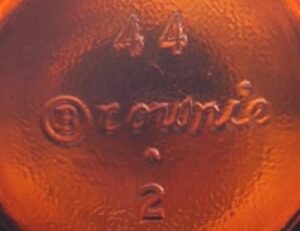
Base of amber Brockway Glass Company “Brownie” beer bottle with 1944 date code (Photo courtesy of Dan) Brockway Glass Company (see “B in a circle”). They appear to date from the mid- 1940s. A brief mention of these bottles is made in this article about early Non-Returnable type beer bottles: https://sha.org/bottle/pdffiles/NRBeers.pdf . This particular brand name has nothing to do with the ACL “Brownie” brand soda bottles.
- B & S …………….unidentified with certainty. Seen on base of pickle or “chow chow” bottle, probably from Great Britain. A possibility would be Thomas Barron & Sons, an obscure bottle maker operating circa early 1890s. The initials are also found on the bottom of some Worcestershire Sauce bottles, also indicating an English origin.
- B. T. & Co. (on the base of “Mason’s Patent Nov 30TH 1858” style fruit jars)……….. Bodine, Thomas & Company, Williamstown, Pennsylvania (c. 1864-c. 1891). Most of the Nov 30TH 1858-type jars with these initials on the base were probably manufactured in the 1864-1867 period. The factory was known as the Williamstown Glass Works. For more info on the Bodine firms and the marks they used, see this .pdf file article by Bill Lockhart et al: https://sha.org/bottle/pdffiles/Bodine.pdf
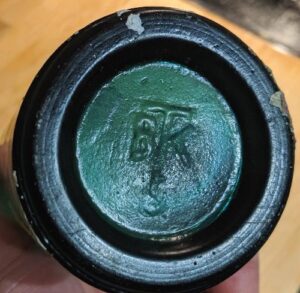
BTK marking on base of teal aqua-green bottle (photo courtesy of Eric Hulten) - BTK monogram (shown) ……………… This mark, which might also be read as “TBK” or “BKT”, shown at right, appears on the base of a crown-lip style soda, beer or mineral water bottle (of an “Apollinarus” style) of a rather dark teal/aquamarine glass, found by Eric Hulten when diving off the coast of Guam. [Update 2/11/2023] – archeologist Nina Peck reported a similar bottle also found on Guam – during excavation for utility lines – and she was able to contact a retired professor and glass manufacturing industry researcher named Mr. Shoji, (庄司太一) of Tokyo, who relayed that the mark almost certainly stands for the Kirin Brewery Company’s Tonda glass bottle manufacturing plant, located in Suotonda-cho, Shinnanyo, Shunan City, Yamaguchi Prefecture, Japan. According to one website (kirinholdings.com), the Tonda bottle plant was started in 1938. That bottle factory was sold to KYC Corporation in 1992. (Thank you to Nina Peck for your kind help with this mark!!)
- Bumps (dots or bumps on the base of containers)………. please see my entry under “Dots” on Page Two.
- Burgin & Sons………………………… Philadelphia Glass Works, Philadelphia, Pennsylvania. See “Philada Glass Works”.
- Burnett’s Cocoaine………………….. This was actually a hair dressing made with Coconut Oil, promoted as a product guaranteed to give the hair a more luxurious, healthy appearance. Contrary to what some collectors might assume upon finding a bottle with this embossing, the product did not contain cocaine (unlike some of the products being sold in the mid and late 1800s that did indeed contain that ingredient). First sold in 1857 by Joseph Burnett of Southborough, Massachusetts, it was a popular product for many years and was still available into the early 20th century. Several variations of the bottles exist. The glassmaker is uncertain, but it is probable that one or more bottle companies located within or near the Boston area manufactured these bottles. This webpage from the Southborough Historical Society has some information on Joseph Burnett: Joseph Burnett Chronological History.
- Bushwick Glass Works…………….Bushwick Glass Works, Brooklyn, New York (1864-c.1912). More commonly known under the name Brookfield Glass Company. Prolific maker of glass electrical insulators, they also made large quantities of bottles and jars, the great majority of which were not marked with the company name. See my webpage with more info here: Brookfield Glass Company .
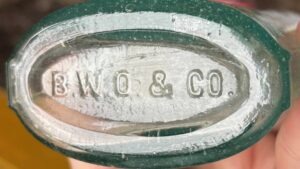
“B. W. O. & CO.” on base of handmade light aqua strap side flask – initials indicating B.W. O’Neil & Company, Boston, MA. This was a jobber, not an actual glass manufacturer. (Photo courtesy of Crystal King). - B. W. O. & CO. ……………….. B. W. O’Neil & Company, Boston, Massachusetts (c. 1882- c. 1918). Initials seen on the base of strap side style liquor flasks. Although this firm claimed to manufacture glass, it was actually a distributor / jobber of glassware, bottles, tumblers, druggist’s items, etc. So the actual glassmaker of bottles with this marking is uncertain. See a 1911 ad for the company on this article by Bill Lockhart et al: https://sha.org/bottle/pdffiles/BOther.pdf
- B superimposed over W (or W superimposed over B)……… Uncertain. See “W superimposed over B” entry on page 5 (S-Z marks).
- B & W (along heel, on scarce early pictorial eagle flask)……….. possibly Burgin & Wood, Millville, NJ (c. 1827-1829)
- B & W (on base of amber whiskey flask, circa 1890-1915, no connection to mark above) ……………….. uncertain meaning.
- B Z (Letter “B” positioned above a larger “Z”, on the base of glass paperweights)………….. Zimmerman Art Glass Company, Corydon, Indiana (1963-to present). This particular mark indicates a piece made by Bart Zimmerman (one of two sons of owner Joseph Zimmerman) who joined the company in 1983. Tragically, in August of 2008, Bart (along with another victim) drowned in an attempt to help rescue some fishermen whose boat had overturned in a boating accident on the Ohio River below Cannelton Dam. Also, see “K Z” and “Z” entries.
[ A – B ] [ C – D ] [ E – L ] [ M – R ] [ S – Z ]
Please click here to go to my website Home Page.
ADVERTISEMENT

